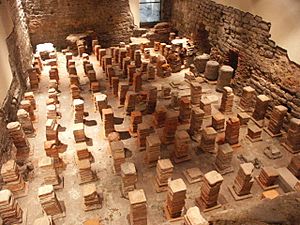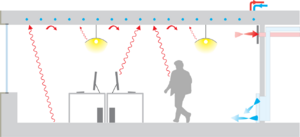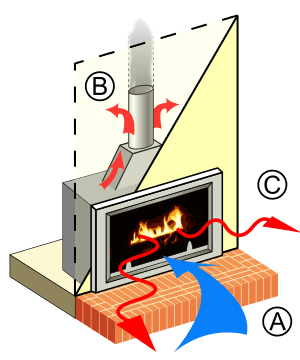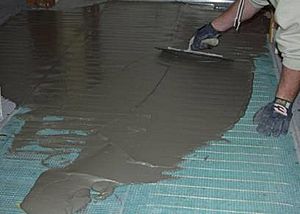Radiant heating facts for kids
Radiant heating is a way to warm up a space by making surfaces hot. Instead of heating the air, it heats objects and people directly. Think of how the sun warms your skin, even on a cold day. That's radiant heat!
This method has been used for a very long time. The Romans and the Koreans used it in their buildings. Radiant heating can be much better at warming a room than just blowing hot air around.
The most common type of radiant heating is found under the floor. But you can also find systems in walls or ceilings. Radiant heating can even warm up outdoor areas like a patio!
Contents
History of Radiant Heating

The Romans were pioneers in using underfloor heating. They built systems called hypocausts. These systems used warm air to heat the floors.
The floors were built on top of many brick pillars. This created a space underneath. Hot air and steam from a furnace would flow through this space. The hot air then went up chimneys in the walls. This way, the hot air never entered the living areas. Building and keeping these systems running was very costly. So, only wealthy Romans could afford them.
In Korea, people have used radiant underfloor heating for about 2000 years. Their system is called Ondol, which means "warm stone." Ondol uses stones and underground ducts to move warm air. This air came from the kitchen to heat other rooms in the house.
Today, many Korean homes still use ondol. But now, they use hot water or electric systems instead of just warm air. An American architect named Frank Lloyd Wright learned about ondol in the early 1900s. He then used similar ideas in many of his own building designs. Wright also helped create hot water underfloor heating systems.
Types of Radiant Heating
Underfloor Heating Systems
The most popular type of radiant heating is underfloor heating. There are three main ways these systems work: using hot air, hot water, or electricity.
Hot Air Systems
Hot air systems use warm air to heat the floor. They are similar to the ancient Roman systems. However, air doesn't hold heat very well. Because of this, hot air systems are not usually suggested for homes today.
Hot Water Systems
Hot water systems are very common, especially in cold places. They are often the most affordable choice. In these systems, a boiler heats water. This hot water is then pumped through pipes laid under the floor.
You can even make hot water systems more eco-friendly. They can be combined with solar thermal energy. This means sunlight is used to heat the water. Then, this solar-heated water warms your floors.
These systems can also cool a building. Cold water is run through the pipes instead. But this can be tricky to use correctly. Sometimes, condensation can form on the floor. This might damage wood floors or rugs. It could also make the floor slippery and cause falls.
Electric Systems
Electric systems use special electric cables. These cables are placed under the floor. Electricity heats the cables, which then warm the floor. These systems can turn on and off much faster than hot water systems.
However, electric systems are often more expensive to run. This is because electricity can be costly. This is especially true if a hot water system uses solar energy. You can lower the cost of electric heating. Try setting the floor to heat during off-peak hours, like late at night. Then, turn it off during the day. Electric systems are also less environmentally friendly. Electricity often comes from burning fossil fuels. This adds to carbon emissions.
How Underfloor Systems Are Installed
Underfloor radiant heating systems can be installed in two ways: wet or dry. Wet systems involve laying the pipes or cables down. Then, concrete is poured over them. Concrete floors hold heat very well. But they can take a long time to get warm.
Dry systems run in an open space. This space is usually between the foundation and the floor above. Dry systems can be less efficient. This is because they also have to heat the air in that space. However, dry systems are much easier to fix. If there's a leak or a problem, they are easier to reach.
You can use almost any type of flooring with underfloor heating. But ceramic tiles are the most popular. They transfer and store heat very well. Materials like wood, carpet, or linoleum tile don't transfer heat as well. If you use these materials, the heating system needs to be set to a higher temperature.
Wall and Overhead Heating
Wall and overhead radiant heating systems often use aluminum panels. These panels are hung on walls or ceilings. Like underfloor systems, they can be heated by hot water or electricity.
Hot water panels can sometimes leak. So, electric panels are more common for walls and ceilings. These panels can't heat as large an area as an underfloor system. But they can be turned on and off quickly. This is useful when someone enters or leaves a room. Turning off panels in empty rooms can help save energy costs.
Outdoor Heating
Using radiant heating outdoors makes a lot of sense. Heating the air outside is difficult because the air is always moving. Radiant heaters warm you directly, not the air around you.
Outdoor radiant heaters are almost always electric. They are usually portable, meaning you can move them around. However, you can also have underfloor radiant heating installed under an outdoor patio.
Other pages
Images for kids
See also
 In Spanish: Calefacción radiante para niños
In Spanish: Calefacción radiante para niños






